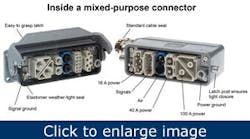In brief:
- Customized hybrid connectors represent one way to ensure that disassembled OEM hardware can be made operational at the plant site more quickly than hardwiring.
- Although hybrid, mixed-purpose connectors have a cost, it’s recovered each time a machine needs troubleshooting on the plant floor.
Most industrial equipment, whether intended for indoor or outdoor use, contains extensive electrical wiring between its components and subsystems. When the equipment is manufactured, the machine builder typically assembles and tests most of the system at its plant before shipment. Then it’s disassembled, including disconnecting much of the point-to-point wiring, and shipped to the customer’s site. There it’s reassembled, the wiring reconnected and any remaining electrical wiring completed.
If point-to-point hardwiring errors occur during installation, it can cause equipment damage on startup or, at a minimum, cause startup delays to accommodate troubleshooting and repairs.
Hardwiring also can complicate subsequent maintenance electrical problem troubleshooting. Connectorized wiring can make both equipment production and subsequent maintenance more efficient and cost-effective.
Connectorization
Most plant engineers are familiar with the concept of a communications bus, with drops coming off a main trunk cable; it’s how Ethernet and other common networks are assembled. What might be less familiar is that power for motors and control signals can be distributed the same way. In fact, connectors are available that make it possible to use a bus structure to carry both motor power and control signals, using a composite trunk cable containing both kinds of wires, and with individual power and control drops to each motor or device.
A cable bus system can be custom-designed and assembled at the factory along with the equipment on which it will be used. The bus cable is run, and drops are connected as the equipment is assembled. After factory acceptance testing, the connectors are unplugged and then plugged back in at the customer’s site.
[pullquote]This can save money during equipment manufacturing, debugging and servicing in the field. Designing equipment as a series of modules can make manufacturing easier. It allows the equipment to be shipped in smaller pieces and can make planning for expansion simpler. In addition it makes it feasible to pre-build standard components such as control panels, motor assemblies and power distribution boxes, which will be plugged together during assembly. This can lead to a better-looking, neater design, with less panel clutter. And it makes troubleshooting easier.
During assembly, connectorization can cut initial wiring costs by reducing or eliminating the need for rigid or semi-rigid conduit. A primary reason for armored wiring is to reduce the chance of severing wires in a cable, which in point-to-point wiring could require a large amount of time to repair or replace. Connectorized wiring allows a cable section to be quickly replaced by unplugging it and plugging in a new section. For a similar reason, it cuts debugging and testing costs. By using pre-wired and tested cable assemblies, connectorization can improve manufacturing efficiencies and logistics by allowing staged panel assembly. With everything connected by plugs, disassembly for shipment involves unplugging the different parts. There’s no need to disconnect I/O, power, pneumatics and signal cables separately when hybrid connectors are used (Figure 1).
Figure 1. Example of a multipurpose hybrid connector for pre-assembled cabling.
Installation at the plant site also can be faster with connectorization. There’s no need to test, rewire and troubleshoot wiring; simply plug everything in. This means fewer wiring errors. And because this is faster than connecting individual wiring, it reduces on-site costs for personnel and travel expenses.
Once the equipment is up and running, it must be maintained, and connectorization can help here, as well. With everything in plug-and-play modules, it’s easy for maintenance personnel to unplug cables to eliminate wiring problems and isolate the source of a malfunction. When something fails, it can be replaced quickly.
Cory Jenkins is product manager at Harting. He can be reached at [email protected]. Richard Carlson is senior product manager for Harting North America. He can be reached at [email protected].
